Archival Treasures: 25 Years of Caring for Hershey’s History
2015 marks the 30th anniversary of the Hershey Community Archives. This exhibit highlights some of the many treasures found in the collections. Just as Hershey’s history is not only about Milton Hershey, the Archives’ collections contain information about the many businesses, organizations, events and individuals that have shaped the community.
“Please send me a box of your chocolates as they are very hard to get here.”
By 1909, Hershey Chocolate Company was the largest confectionery company in the United States, with net sales of over $2 million. In 1910, sales nearly doubled.
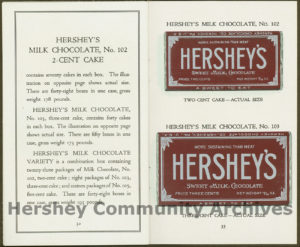
Hershey’s Milk Chocolate bars could be found throughout the United States and beyond, as evidence by this postcard postmarked in Tientsin, China.
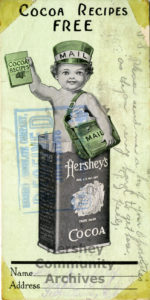
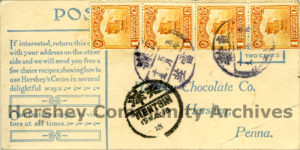
“Sorry that I cannot be with [you] this evening when our baby will be christened stop”
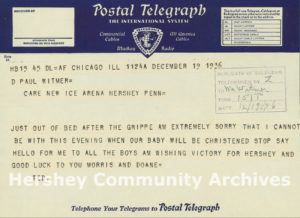
When Hershey’s builder, D. Paul Witmer needed to build a new ice arena for Hershey’s popular ice hockey team, he turned to Anton Tedesko, a German engineer with the Chicago design-construction firm Roberts and Schaefer. Tedesko was the design engineer who developed the concept of thin shelled concrete structures. The Hershey Arena would be the largest monolithic concrete roof structure in North America. Milton Hershey was initially skeptical but the design’s innovation and novelty excited him and he soon gave his approval. Construction began March 11, 1936 and was completed in late fall for the Arena’s opening on December 19, 1936.
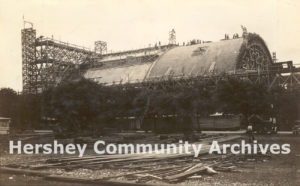
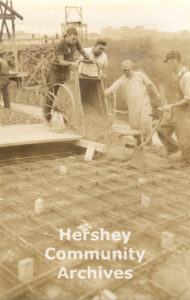
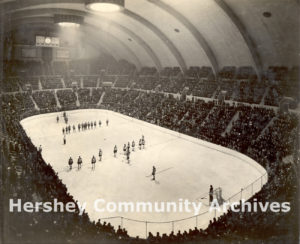
“The more beautiful you make something which people can see and use, the more enjoyment they will get out of it.”

The beautiful stained glass art created by J. Horace Rudy and the Rudy Glass Company of York, Pennsylvania can be found throughout the Hershey community. The company’s work was incorporated in many of Hershey’s most prominent buildings, including Milton Hershey’s home (High Point), 1 West Chocolate Avenue, Hershey Community Building and Hershey Theatre.
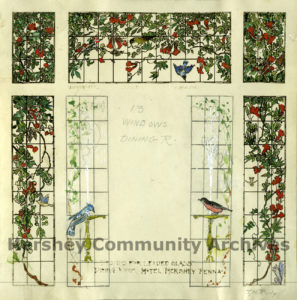
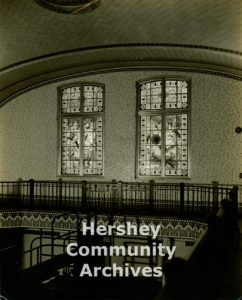

“Seating: 1904 people. Motion pictures, musical and deluxe revues of Broadway merit or vaudeville.”
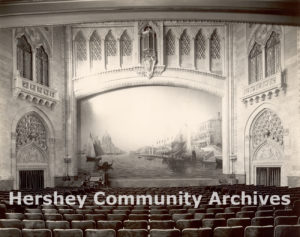
Hershey dedicated its new Theatre during the town’s 30th anniversary celebration held over Labor Day weekend in 1933.
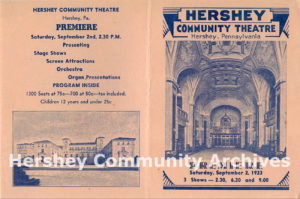
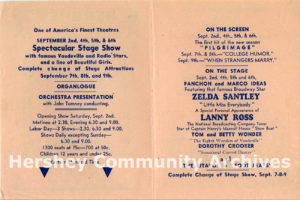
That weekend, Hershey Theatre offered a daily program of movies and vaudeville performances featuring nationally popular singers, comediennes, dancers and acrobatics. Also featured were “The Hersheyettes,” 16 female dancers performing precision routines. Vaudeville continued to be a regular part of Hershey’s programming until 1938. Legendary performers such as ventriloquist Edgar Bergen, Ethel Barrymore, Roy Rogers, Fanny Brice, Jackie Cooper and Blackstone the Magician all appeared at Hershey Theatre during the 1930s.

“Children and teachers take their breakfast together at 7:30 a.m.”
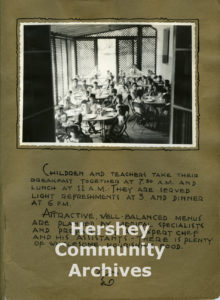
The flagship of Milton Hershey’s Cuban holdings was a new sugar mill and town, Central Hershey*, located near Santa Curz. Once Central Hershey was well established, Hershey purchased other centrals, some for the mill and others for the sugar plantations attached to them. In 1920 he bought Central Rosario. In 1925 he bought Central Carmen and Central San Antonio and in 1927 Central Jesus Maria.
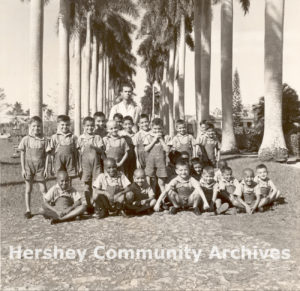
At Rosario Mr. Hershey also founded an orphan school, the Hershey Agricultural School (later known as Colonia Infantil Hershey). Hershey operated it for 10 years before transferring its operation to a local orphanage. The first students were boys whose parents had been killed in a 1923 train accident on the Hershey Cuban Railroad. The primary object of this school was to train boys for jobs on the farm or in industry. Milton Hershey had great plans for it, including building a model sugar mill and teaching modern agricultural methods to prepare the boys for careers in Cuba’s principal industries.
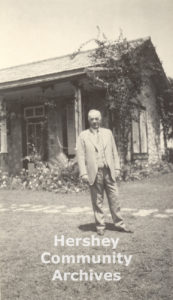
*Central = Cuban word referring to a sugar mill and its surrounding town.